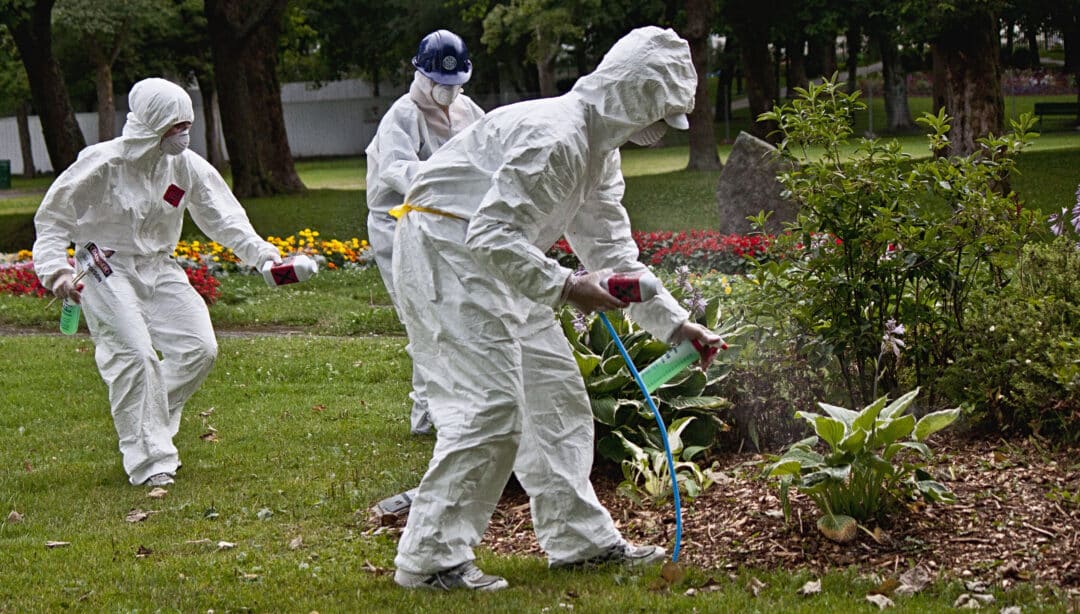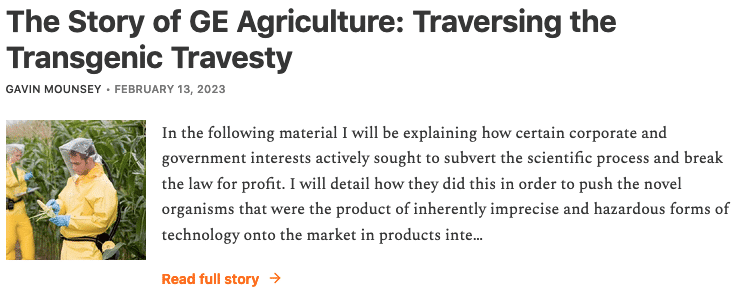
The History Of “Round Up” and pathways for Glyphosate Detox (from the soil and human body)
by Gavin Mounsey | Oct 9, 2024
In light of the fact that here in Canada we have a government, academic institutions and agricultural system still promoting this substance that has caused (and continues to cause so much death, suffering and ecological devastation) I felt like I needed re-iterate the facts about this deadly biocide (that is being promoted as “safe and effective”).
I even recently discovered that National Park Ecologists and regional conservation authorities where we live are using and promoting glyphosate as part of their “restoration” efforts (in exercises in futility to fight “invasive plants” to make room for native plants). These people are poisoning the water and the soil and calling it “restoration”!
That being said I know all about being gaslit and also choosing to remain complacent when it comes to substances like this, as some of the big vineyards I used to work at in my 20-s were spraying copious amounts of this stuff and I never said anything as we were told it was “safe and effective”. I heard some people talking about the health and ecological impacts even back then but dismissed them as I did not have the courage and integrity to do my own homework and take a stand so I just accepted it as “business as usual”.
Also, no round up would mean hand pulling weeds in an industrial monoculture grape vineyard like that so many avoid the facts as it would be inconvenient to stop using it.
So I know all too well about the gravity of “group think” and the influence of complacent corner cutting based justifications when it comes to stuff like this.
Thus, I felt I should shine some light on the real facts about this substance to clear up any confusion for those still drinking the corporate/government propaganda Kool-Aid.
What is Glyphosate and where did it come from?

For those that prefer a video summary rather than reading a lot of dry scientific data, Zach Bush provides a valid nutshell presentation here:
Glyphosate’s Properties: First Patented in 1964
Glyphosate as a Mineral Chelator
A chelator binds to a mineral to change its physical properties without becoming part of the molecule. There are two primary types of chelation (relative to production agriculture or in nature).
A friendly chelator prevents a mineral or element from being tied up by others minerals or the soil. Humic substances (humic acid, fulvic acid or tannic acid) are examples of friendly chelators because they can hold the mineral in a protective manner but release the mineral physiologically or microbially to subsequently make the mineral available to the plants growing in the soil.
A strong chelator like glyphosate grabs onto the mineral(s) or element(s) and makes them bio-unavailable. Glyphosate performs this function in two ways because it is a strong chelator and a biocidal/antimicrobial product. It holds the mineral/nutrient relative to the charges involved with chelation. Glyphosate also damages the microorganisms that would in many cases be the most effective means of making the mineral or nutrient available to a growing plant.
It has been proven that glyphosate lowers the mineral content and physiological availability of nutrients in a growing crop.
Glyphosate chelates Calcium (Ca), Magnesium (Mg), Manganese (Mn), Zinc (Zn), Iron (FE), Copper (Cu), Nickel (Ni), Cobalt (Co), Boron (B), Molybdenum (Mo), Selenium (Se) & Potassium (K). It takes an extremely small amount of glyphosate to cause this bio-unavailability because of how effective glyphosate is as a chelator. If glyphosate is present in a substance(s), nutrient availability will be questionable.
It has been proven that glyphosate lowers the mineral content and physiological availability of nutrients in a growing crop. Glyphosate reduced seed and leaf concentrations of calcium, manganese, magnesium, and iron in non-glyphosate resistant soybean. It has also been proven that glyphosate also reduces the nutrient, content in the grain/seed of a glyphosate resistant (GR) crop that is sprayed with GBH. There is nothing in the genetically engineered, GR crop that enables the GR crop to deal with the chelating effects of the glyphosate herbicide. GR crops can simply survive or tolerate the application of the GBHs.
Some researchers believe that glyphosate can lower the test weight of grain due to its chelating effects, but it cannot be substantiated scientifically. Due to the inability in lab analysis equipment and capabilities relevant to nutrient/nutritional analysis, it is difficult to determine if a mineral is present, and available, or unavailable due to the presence of glyphosate residue. The mineral can be detected to be present but it is uncertain if it is available for utilization with MOST labs’ testing capabilities.
Glyphosate residue testing requires very specific equipment and expertise on how to properly conduct this type of analysis. It is a very difficult to analyze for the presence of glyphosate residue as recoveries from ‘spiked’ samples can be as low as 60 % with certain analytical systems.
Weeds are developing resistance to the diseases, not the glyphosate.
Glyphosate as an Herbicide – Patented in 1969
Although glyphosate is registered as an herbicide, it has been repeatedly documented (since 1984) that glyphosate does not kill a weed directly. Glyphosate shuts down the plants’ defense mechanism making it susceptible to disease causing organisms which are actually responsible for killing a susceptible plant that has been sprayed with a GBH. This has been demonstrated in several scientific studies by growing plants in sterile soil and then spraying them with a GBH. The plant will stop growing for up to 10 – 14 days and then begin to grow again after the growth hormones can function properly when the plant recovers/receives critic nutrients/minerals from the soil.
The susceptible sprayed plant does NOT DIE but only stops growing. This has also been demonstrated by applying a fungicide with the glyphosate herbicide. The disease(s) that kill plants that have been sprayed with glyphosate are promoted by the pathogenic fungi in the soil. The fungicide stops the fungal disease and thus prevents the herbicidal activity so the plants do not die. It has been stated for the ease of the lay person to better understand or make an association that glyphosate “gives the plants a condition similar to AIDS”. Again, it’s a defense mechanism in a plant (comparable to a human’s immune system) that is rendered inactive due to the presence of glyphosate. Weeds are developing resistance to the diseases, not the glyphosate. This is just one reason, for the ever growing number of SUPER WEEDS.
Glyphosate has been proven to stimulate the growth of the opportunistic/pathogenic disease-causing organisms at very low levels.
Glyphosate as an Antimicrobial Agent- Patented in 2004
Monsanto was granted a patent on glyphosate as an antibiotic (or parasite control product) in August 2004 and this patent was expanded in 2010. The company applied for the patent in August 2003, yet concurrently while the patent was being reviewed and approved, they denied that glyphosate could cause any possible damage to the soil or soil microorganisms.
Dr. Robert Kremer worked for the USDA ARS at Columbia, Missouri. He was unable for many years to get any of his detailed precise research published on the damaging effects of glyphosate to the soil, soil organisms and plants. This was due to Monsanto’s influence in the scientific journal arena in the United States. Dr. Kremer submitted his research to the European Journal of Agronomy to finally get the work published. The most interesting part about glyphosate’s antimicrobial effect is that it affects beneficial organisms at much lower doses than it does the opportunistic or pathogenic disease-causing organisms. This has been documented in soil by Dr. Kremer & others, in livestock; chickens by Dr. Monika Krueger as well as causing botulism in cattle.
It bears repeating that glyphosate has been proven to stimulate the growth of the opportunistic/pathogenic disease-causing organisms at very low levels. A consequence of this differential toxicity reduces the population of the biological control organisms (the good bugs) and increases the population of the opportunistic or disease causing organisms (the bad bugs). Fusarium is an example of a disease causing organism.
Glyphosate also causes a continual increased veracity or intensity of the opportunistic organisms. So, the bad bugs continue to maintain or increase their population (throughout the growing season) and keep getting stronger wherever/whenever glyphosate is present in the environment. This has not been documented in humans as it is theoretically unethical to do research on humans but as we know it occurs every day without their permission or knowledge as unsuspecting victims consume food that contains glyphosate residue.
Thanks to the excellent clinical work of Dr. Michelle Perro (an outstanding pediatrician who practices integrative medicine and coauthor of What’s Making Our Children Sick) and the pioneering scientific research of Dr. Dana Stanley (reestablishment of specific beneficial gut microorganisms) many of the damaging effects of glyphosate in the gut of livestock and humans are better understood. Dr. Monika Krueger has also been very instrumental in pioneering research in remediating glyphosate’s negative effects in livestock that has subsequently benefitted humans.
Glyphosate is an aminophosphonic analogue of the natural amino acid glycine. Glycine is a ubiquitous amino acid important in plants for the management of stress and for collagen growth in humans. The science on this aspect of glyphosate is still young and definitely requires more research.
Glyphosate is an endocrine disruptor . An endocrine disruptor in essence causes a malfunction of normal cellular development. In a developing fetus this can cause birth defects. In an adult this can cause metabolic disfunction or the growth of abnormal cells (tumors).
Glyphosate was classified as a probable carcinogen by International Agency for Research on Cancer (IARC) in March of 2015. This decision has been aggressively contested by industry and also disputed by the EPA and other regulatory agencies. Dr. Christopher J. Portier just published a paper on the science supporting the IARC cancer decision.
Dr. Charles Benbrook authored an excellent paper on comparing the science that IARC used and the science that EPA used in reaching their varying conclusions on glyphosate. It is difficult to understand how EPA justified its controversial conclusion until you see the limited scope of the science they reviewed.
In summary, Glyphosate is a broad spectrum chelator, a nonselective herbicide, an extremely effective antimicrobial agent, a synthetic amino acid, an endocrine disruptor and a probable carcinogen. The world has never experienced such a multi-pronged compound used liberally and indiscriminately. The history books someday could well state that “glyphosate is the most chronically toxic compound ever indiscriminately released into the environment”.
So before glyphosate was even marketed as round up, it’s been a:
👉Failed pharmaceutical antibiotic
👉Chelating and descaling agent
👉Herbicide
EPA Collusion
When you look at the publicly available archive of EPA documents from the earliest days of the agency’s consideration of glyphosate, significant portions of the relevant documents have either been partially redacted or omitted entirely. But this archived material reveals that EPA staff scientists, who found much of the data submitted by Monsanto unacceptable, did place great weight upon a 1983 mouse study that showed glyphosate was carcinogenic.
Yet their interpretation was subsequently reversed by EPA upper management and advisory boards, apparently under pressure from Monsanto. In years to come, that pivotal 1983 mouse study would be buried under layers of misleading analysis to obscure its meaning. Today, the EPA and Monsanto continue to cite that study as evidence that glyphosate poses no public health risk, even though the study’s actual evidence indicates otherwise.
Meanwhile, the EPA has overlooked a growing body of research suggesting glyphosate is dangerous. In March 2015, the International Agency for Research on Cancer (IARC) determined that glyphosate is “probably carcinogenic to humans” based on multiple peer-reviewed studies published since 2001. But the EPA has not changed its classification.
The Roundup Boom
After being marketed as Roundup, it quickly took off in the agricultural sector. Big Ag grew to depend on this product for their production unlike any other “cide” out there. It was like hitting the easy button. Farmers and backyard enthusiasts alike no longer needed to worry about weeds. In addition, Big Ag learned they could fast track the harvest of grains by spraying it on mature crops to reduce drying times.
In 1996, “Roundup Ready” or GMO crops were introduced and Glyphosate sales EXPLODED. Farmers could now spray this chemical right ON their crops to kill weeds without damaging the crop at all. In addition, the use of glyphosate surged due to more frequent applications, increased usage across various fields, and higher quantities being applied each time.
Glyphosate Usage
💀From 1974 – present over 18.9 billion pounds lbs of glyphosate has been applied.
💀Two thirds of that has been applied in just the last 10 years
💀Iowa and Illinois, the leading producers of corn and soy, were responsible for 15% of the country’s glyphosate usage in 2019.
Let’s dig into the mounting health concerns against glyphosate:
Cancer
Numerous studies have investigated how glyphosate can cause cellular changes in humans, potentially leading to cancer. One such study found that the exposure to glyphosate increases the risk of non-hodgkin’s lymphoma by 41%.
Hormonal Disruption
Glyphosate is also suspected of being an endocrine disruptor, meaning it can interfere with reproductive hormones and other biological processes. Studies have suggested that even at low levels, glyphosate can disrupt the action of estrogen, testosterone, and other hormones. Such disruptions can lead to reproductive problems, obesity, diabetes, and even thyroid issues.
Impact on Microbiomes
I’m sure you’ve heard a ton about gut health in the past few years. Our microbiome is so incredibly important to all the systems of our body from nutrition to mental health. Studies show that it inhibits the growth of beneficial gut bacteria, essential for digestion, immunity, and overall health. And this disruption is not only limited to the human microbiota, EVERYTHING has a microbiome. Livestock, wildlife, insects, soil, water, plants, air, rocks, etc. The extensive use of Glyphosate causes these microscopic systems to fail at a giant scale.
Developmental and Reproductive Issues
Research points to glyphosate’s potential role in developmental and reproductive problems. Exposure during pregnancy has been linked to developmental issues in offspring, and some studies suggest it may affect fertility and increase the risk of miscarriage.
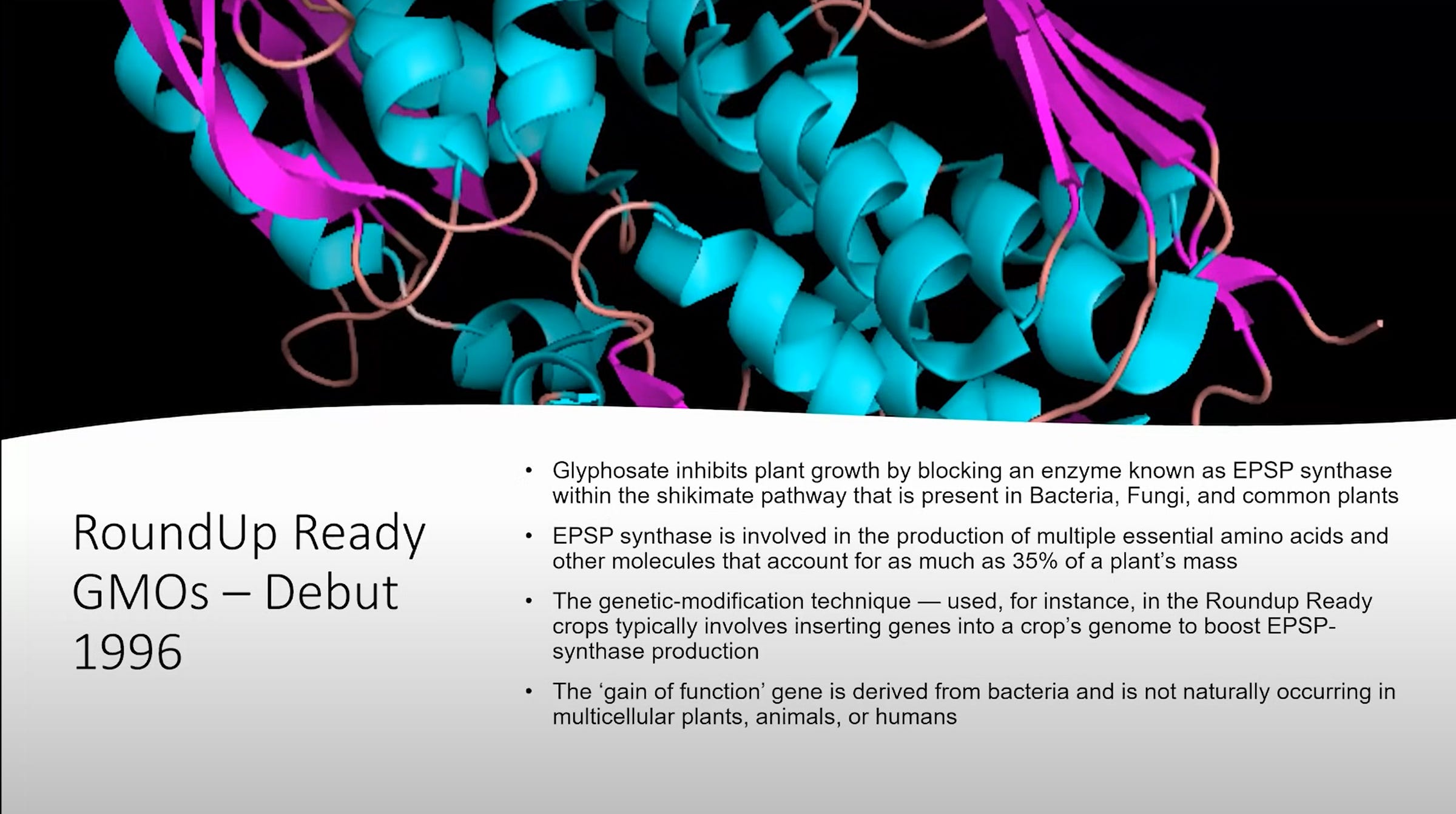
The proponents of GMO crops argue that they can engineer plants to put out higher nutritional value and greater crop yields, yet in direct contrast to their claims the nutritional value of crops that switched to GMO seeds have in fact decreased and on top of that the yields are also down due to the extensive damage the GMO associated herbicides have done to the beneficial ecology in the soil (insects, microbes and symbiotic fungi).
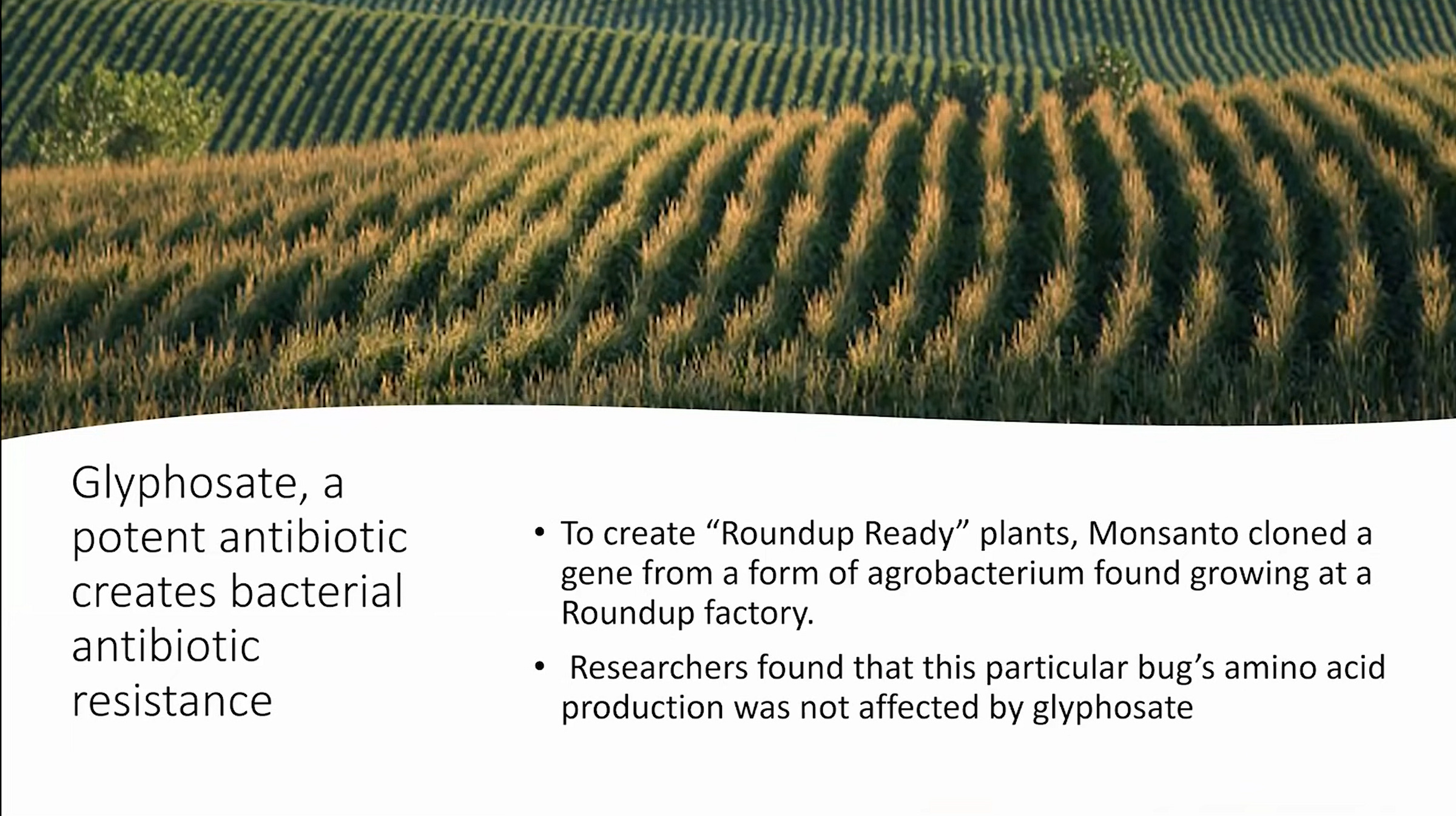
The continued use of excessive amounts of highly toxic chemicals that are used in conjunction with GMO farming practices has left the water contaminated, the air contaminated and the soil depleted.
For more information on the history of glyphosate read “Merchants of Poison: A case study in pesticide industry science denial on glyphosate (an excerpt)”
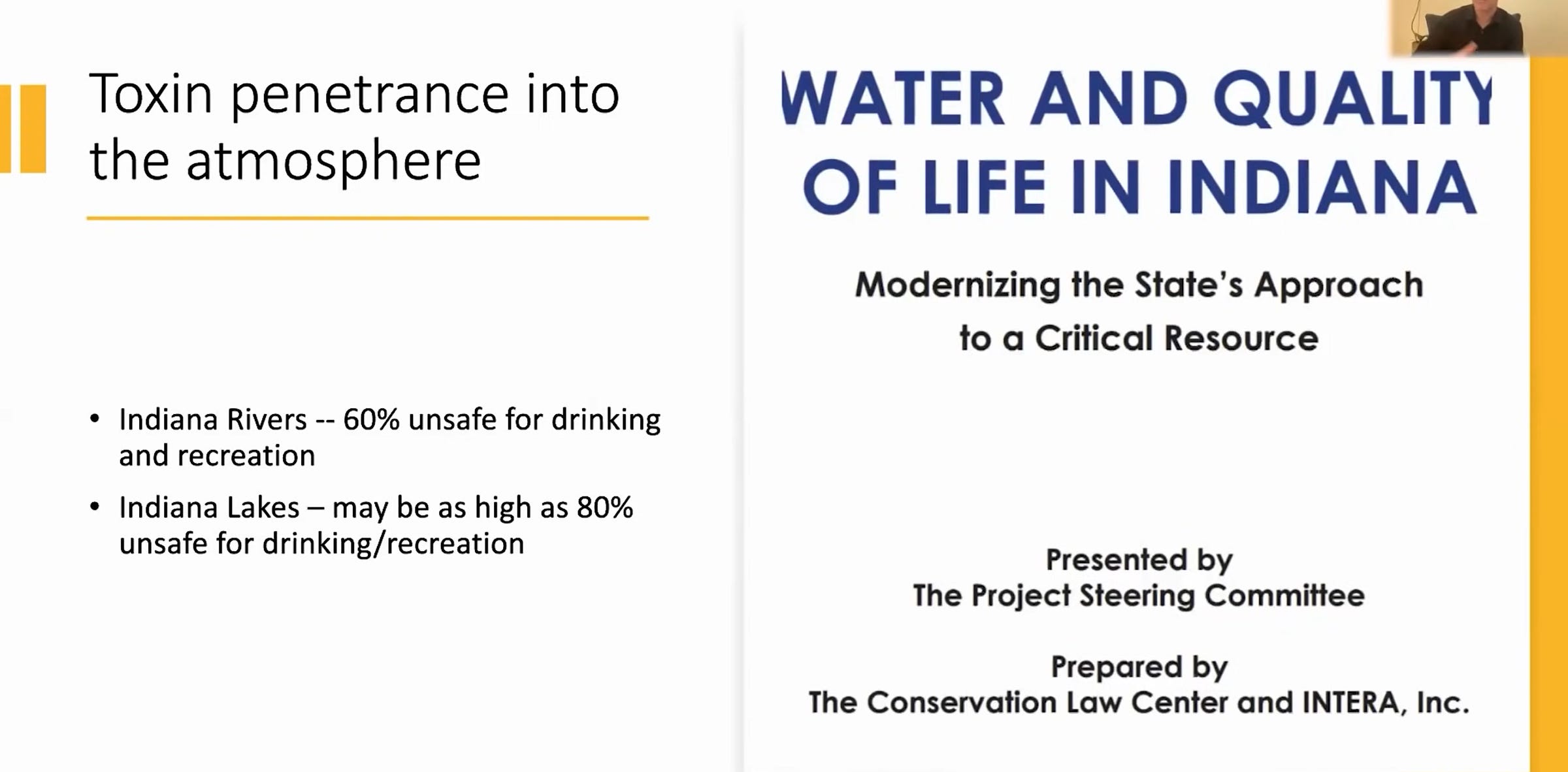
These practices have killed the soil life over vast expanses, which means that the dead and desolate dirt requires the introduction of large amounts of petroleum based fertilizers annually in order for the land to continue producing crops using industrial methods.
These practices are not only doing grievous damage to human and animal health in the present, they are also destroying the living soil and surrounding interconnected ecology of the farm land and in doing so directly threatening future generation’s ability to be self-sustaining and /or grow healthy food for themselves.
For more info on how the Big Ag and Big Pharma cartels use Glyphosate as one of their weapons and profiteering tools of choice in dominating the food supply and creating endless life long patients for big pharma read:
and:
As I explain in detail in the article above, glyphosate is sprayed prolifically onto our food due to GMO Ag practices and this chemical is ending up in humans through an array of exposure sources (food, water and air). Thus, before I get into solutions for the GMO seed take over with my article on seed saving I want to provide info on how to get this dangerous chemical out of the human body and also provide some info on bioremediating glyphosate contaminated soil.
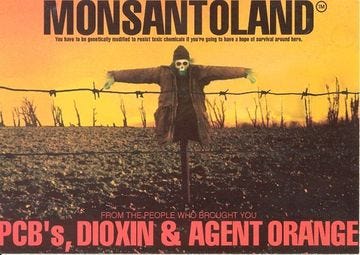
For more information read Merchants of Poison: A case study in pesticide industry science denial on glyphosate (an excerpt)
Now I am not someone that just points out the ugliness of our world and how corporations and governments are trying to poison and oppress us without offering some actionable intelligence as well. So now for some Solutions:
Glyphosate Detox
Based on the scientific studies to-date, there are a number of natural foods/substances that have shown positive results in detoxifying and reducing the toxic effects of glyphosate exposure. Always ensure you are getting at the very least organically grown or grow / forage for it yourself if you want an effective detox.
Foods:
– Raphanus sativus (Radish)
– Dark Green vegetables
– Probiotic/fermented foods (such as Sauerkraut, kimchi and sauerkraut/kimchi juice)
Minerals:
– Sulfur
– Manganese
– Fulvic acid
– Humic acid
and/or a product called “ION Gut Health” (developed by Dr.Zach Bush and his team)
Charcoal and Clay:
– Activated charcoal
– Bentonite clay
Herbs:
– Eleutherococcus senticosus (Siberian Ginseng)
– Taraxacum officinalis (Dandelion)
– Rhamnus frangula (Alder buckthorn)
– Rhodiola rosea (Rhodiola)
– Carduus marianus (Silybum marianum; milk thistle)
– Arctium lappa (Burdock root)
– Berberis vulgaris (Barberry; the active ingredient in barberry is berberine)
– Chelidonium majus (Greater celandine)
– Withania somnifera (Ashwagandha)
A study published in the December 2014 issue of the Journal of Environmental & Analytical Toxicology ( https://www.hilarispublisher.com/open-access/oral-application-of-charcoal-and-humic-acids-influence-selected-gastrointestinal-microbiota-2161-0525.1000256.pdf ) found that the oral application of certain natural substances were able effectively reduce urinary levels of glyphosate. The researchers used a combination of the following substances (also listed above):
-fulvic acids
-humic acids
-activated charcoal
-bentonite clay
-sauerkraut juice
They concluded that a charcoal-sauerkraut juice combination and humic acids reduced glyphosate excretion by urine and led to the improved health.
Another interesting study from October 2010 published in the Journal of Occupational Medicine and Technology ( https://occup-med.biomedcentral.com/articles/10.1186/1745-6673-6-3#Tab1 ) investigated the mechanism of action of liver cells exposed to glyphosate and possible protection by precise medicinal plant extracts.
Glyphosate, in the form of the Monsanto product Roundup, is able to provoke intracellular disruption in hepatic (liver) cell lines at different levels, but a mixture of specific medicinal plant extracts (included in the list above) can protect to some extent human cell lines against this toxin.
Drs. Joseph Mercola and Stephanie Seneff, PhD, recommend supplementing daily with the amino acid glycine for glyphosate detox.
They describe how (once in the body) the glycine serves to displace the structurally bound glyphosate and reduce its retention / reuse by outnumbering the glyphosate.
(Which brings me to something that was shared to me in a comment from ‘HomeRemedySupply’ (a Corbett Report subscriber)
“Glutathione is the best antioxidant that the body makes.
Glutathione is made up of three amino acids. N-acetylcysteine (NAC) is a major component of glutathione. The other two amino acids are Glycine and Glutamine.”
In the interest of empowering those looking to have food/health sovereignty and decentralized (reliable access to) the above mentioned compounds (and constituent compounds that the body uses to produce Glutathione). Here is a list of whole foods that contain said compounds (so one can grow them at home and/or raise the animals and/or source these foods out locally from farmers rather than depending on supplement supply chains).
𝗙𝗼𝗼𝗱𝘀 𝘁𝗵𝗮𝘁 𝗰𝗼𝗻𝘁𝗮𝗶𝗻 𝗚𝗹𝘆𝗰𝗶𝗻𝗲:
– Spirulina
– Seaweed
– Watercress
– Amaranth (greens and seeds)
– Organic Bone Broth
– Spinach
– Legumes (runner beans, soybeans, peanuts and peanut butter, peas, mung beans, lentils, and kidney beans etc, preferably fermented as miso paste if it is soy beans).
– Organic Gelatin (such as you would use to make jello or gummies)
– Asparagus
– Nuts and seeds (such as pumpkin or squash seeds, hemp seeds, butternuts, walnuts, sunflower seeds, almonds, flax seeds, sesame seeds and chai seeds)
– Cabbage
– Bamboo shoots
– Kale
– Yogurt/ Kefir (from grass fed animals or you`ll get loaded up with glyphosate from their gmo grain feed)
N-acetyl cysteine (NAC) is a supplement form of cysteine.
𝗖𝘆𝘀𝘁𝗲𝗶𝗻𝗲 𝗶𝘀 𝗳𝗼𝘂𝗻𝗱 𝗶𝗻 𝗮 𝗿𝗮𝗻𝗴𝗲 𝗼𝗳 𝗵𝗶𝗴𝗵-𝗽𝗿𝗼𝘁𝗲𝗶𝗻 𝗳𝗼𝗼𝗱𝘀 𝗮𝗻𝗱 𝘀𝗼𝗺𝗲 𝘃𝗲𝗴𝗲𝘁𝗮𝗯𝗹𝗲𝘀/𝗵𝗲𝗿𝗯𝘀, 𝘀𝗼𝗺𝗲 𝗲𝘅𝗮𝗺𝗽𝗹𝗲𝘀 𝗶𝗻𝗰𝗹𝘂𝗱𝗲:– shiitake mushrooms
– spirulina
– yogurt or cheese (from grass fed animals or you`ll get loaded up with glyphosate from their gmo grain feed)
– eggs (from organically raised chickens)
– sunflower seeds
– organic sourdough bread
– Dates
– Ginseng
– legumes (same story as above, fermented is better, especially with soy beans and obviously watch out for the ones dosed with glyphosate)
– Peppers
– Cabbage
– Garlic
– Onions
– Kale
– Nuts (pecans, cashews, hazelnuts, almonds, and Brazil nuts)
– Seeds (sesame seeds, amaranath seeds, hemp seeds etc)
𝗙𝗼𝗼𝗱𝘀 𝘁𝗵𝗮𝘁 𝗰𝗼𝗻𝘁𝗮𝗶𝗻 𝗚𝗹𝘂𝘁𝗮𝗺𝗶𝗻𝗲:
– Spirulina
– Seaweed (such as dulse, nori or kombu)
– Yogurt and Ricotta Cheese (from grass fed animals or you`ll get loaded up with glyphosate from their gmo grain feed)
– Legumes (same story as above)
– Red cabbage
– organic Eggs
– Nuts
– Parsley
– Dark Leafy Greens (such as amaranth greens, mustard greens, spinach, collard greens, kale, lettuce, radish greens, and cilantro, are good sources of glutamine)
– Organic Bone Broth
– Nuts and seeds (such as cashews, hazelnuts, pistachios, coconut milk, pumpkin or squash seeds, hemp seeds, butternuts, walnuts, sunflower seeds, almonds, flax seeds, brazil nuts, sesame seeds and chai seeds).
Bioremediation Of Soil Contaminated With Glyphosate
Through teaming up with diverse soil life, regenerative companies like SymSoil are offering products that can help to remediate soils that have been sprayed with Glyphosate. There are specific species of bacteria and fungi that are great at breaking down the chemical bonds of glyphosate and making the soil safe and more productive to grow in again. These species include Achromobacter, Flavisolibacter, Geobacillus, Pseudosprillum, Rhodobium and Streptomyces bacteria families, as well as Penicillum chrysogenum (a fungi).
For more info:
- https://symsoil.com/coming-soon-2/
- https://www.researchgate.net/publication/8597945_Mineralization_of_Glyphosate_in_Compost-Amended_Soil_Under_Controlled_Conditions
- https://pubmed.ncbi.nlm.nih.gov/35147980/#:~:text=Glyphosate%20levels%20decreased%20significantly%20after,after%20112%20d%20of%20composting.
- https://pubmed.ncbi.nlm.nih.gov/20218528/
- https://www.sciencedirect.com/science/article/abs/pii/S0045653518308464
Through encouraging a diverse population of these species in our thermophilic compost piles we can team up with these microbes to heal soil contaminated by glyphosate. It is also possible to use our thermophilic compost for making actively aerated compost tea that can be applied onto large areas intended for cultivation. This method allows us to scale these organisms up and begin healing the land where we live on a larger scale.
Subscribe to Recipes for Reciprocity
- https://pubmed.ncbi.nlm.nih.gov/38547993/
- https://pubmed.ncbi.nlm.nih.gov/31342895/
- https://pubmed.ncbi.nlm.nih.gov/33636765/
- https://pubmed.ncbi.nlm.nih.gov/28846991/
- https://pubmed.ncbi.nlm.nih.gov/38460584/
- https://pubmed.ncbi.nlm.nih.gov/20136481/
- https://pubmed.ncbi.nlm.nih.gov/38443890/
- https://pubmed.ncbi.nlm.nih.gov/37562738/
- https://www.epa.gov/ingredients-used-pesticide-products/glyphosate
- Medalie, L., Baker, N. T., Shoda, M. E., Stone, W. W., Meyer, M. T., Stets, E. G., & Wilson, M. (2020). Influence of land use and region on glyphosate and aminomethylphosphonic acid in streams in the USA. Science of The Total Environment, 707, 136008. https://doi.org/10.1016/j.scitotenv.2019.136008.
- Kaiser K. (2011). Preliminary study of pesticide drift into the Maya Mountain protected areas of Belize. Bulletin of environmental contamination and toxicology, 86(1), 56–59. https://doi.org/10.1007/s00128-010-0167-x
- (Zhang, L., Rana, I., Shaffer, R. M., Taioli, E., & Sheppard, L. (2019). Exposure to glyphosate-based herbicides and risk for non-Hodgkin lymphoma: A meta-analysis and supporting evidence. Mutation Research/Reviews in Mutation Research, 781, 186-206. https://doi.org/10.1016/j.mrrev.2019.02.001)
- Gasnier, C., Dumont, C., Benachour, N., Clair, E., Chagnon, M. C., & Séralini, G. E. (2009). Glyphosate-based herbicides are toxic and endocrine disruptors in human cell lines. Toxicology, 262(3), 184–191. https://doi.org/10.1016/j.tox.2009.06.006
- Puigbò, P., Leino, L. I., Rainio, M. J., Saikkonen, K., Saloniemi, I., & Helander, M. (2022). Does Glyphosate Affect the Human Microbiota?. Life (Basel, Switzerland), 12(5), 707. https://doi.org/10.3390/life12050707
- (Muñoz, J. P., Bleak, T. C., & Calaf, G. M. (2021). Glyphosate and the key characteristics of an endocrine disruptor: A review. Chemosphere, 270, 128619. https://doi.org/10.1016/j.chemosphere.2020.128619)
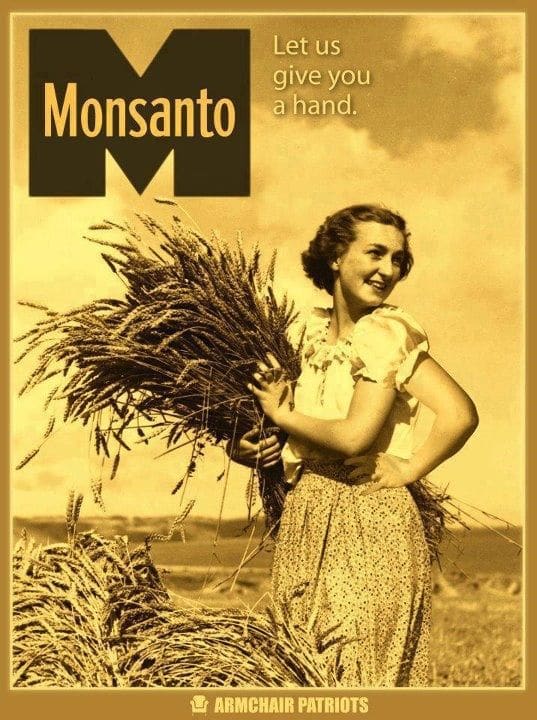
Contact Us
Privacy Policy
Sitemap
© 2025 FM Media Enterprises, Ltd.


